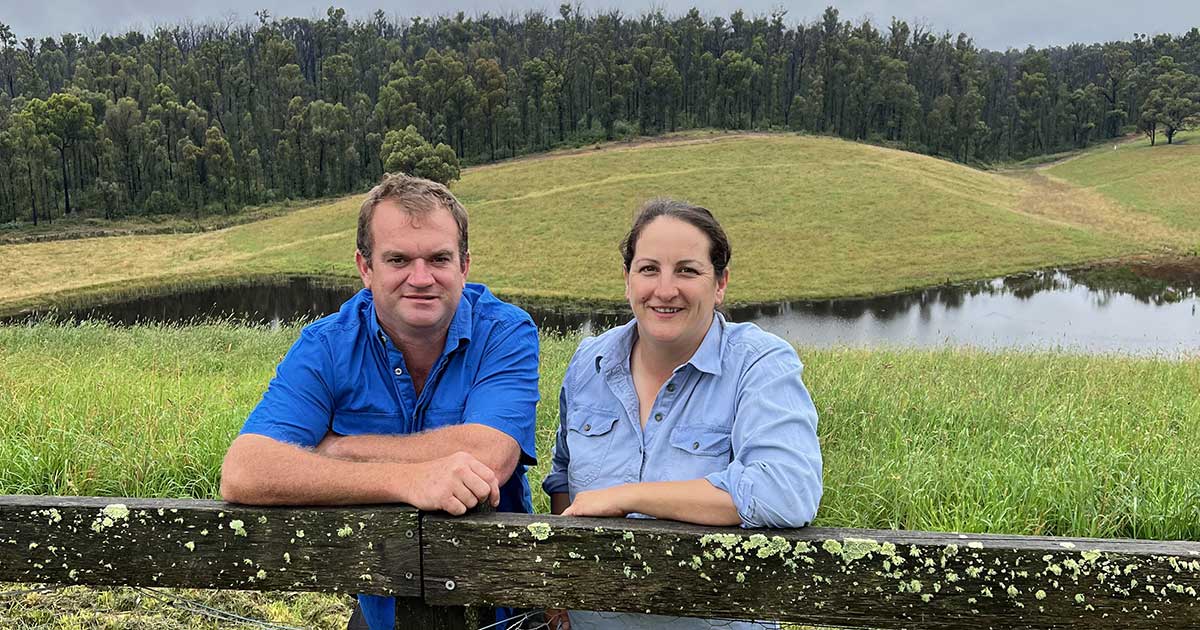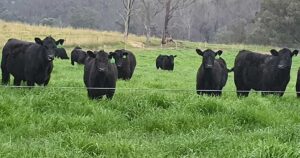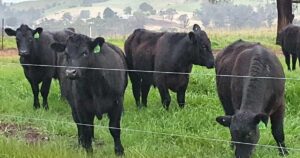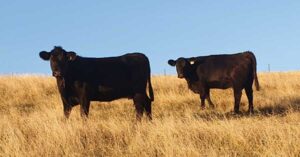Angus cattle thrive through tough times


It was circumstance and chance that led to Jen Smith running an Angus herd.
But she doesn’t regret it one bit.
Jen and her husband Brad, Smith Graziers, Tambo Crossing, Victoria, are passionate about breeding an Angus beast that is both marketable and flexible.

And they haven’t let droughts or bushfires dampen that passion.
The Smiths breed cattle at their Tambo Crossing property, after successfully navigating something many farming families struggle with – succession.
Mrs Smith said they took over the operation 12 years ago from Mr Smith’s parents David and Heather.
“It was a successful succession because of their trust and our commitment,” she said. “We are really grateful for their trust in us. And Brad was committed to it – Brad came out of the womb wanting to farm. We have grown the business so it can support two families.”
In the face of fire
The Smiths used to run Herefords and Merinos, but lost half of their flock in bushfires in 2007.
Being surrounded by the Alpine State Forest, they faced more bushfires, but this time they were better prepared with steel fences and containment areas under water for livestock.
Mrs Smith said surviving two bushfires was made a little easier by the care from others.
“The support from the local community and the Australian community – thank you just doesn’t cut it,” she said.
But the challenges didn’t stop there – during the drought they had to destock their entire Merino flock and some of their Hereford herd.
And when it was time to restock, Angus came into the picture.
“There just weren’t big runs of Hereford cattle available at the time, but there were big runs of Angus cattle, with herd dispersals,” she said.
For a while the Smiths ran both Angus and Herefords herds.
 “Running the two herds side by side, year in and year out, you can compare them,” she said.
“Running the two herds side by side, year in and year out, you can compare them,” she said.
“There are pros and cons for both, and we have been really blessed in Gippsland having really good seedstock available.”
“For us, Angus cattle offer a diversity of market access. There is a greater demand for them.”
She said with genomic testing as well as advances in stock handling, there had been improvements made in the breed.
“They’ve also made big gains in the Angus temperament. We just haven’t had the animal health problems with Angus, and that was a factor in our decision making.”
Last year they switched their herd to Angus, now running about 300 pure Angus breeders and 1200 composite ewes.
Cattle are bred at the home farm at Tambo Crossing and grown out at the property at Clifton Creek, near Bairnsdale.
Yard time
Joining takes place for a spring calving, and when it comes to bulls, who is working in the yards plays a big role in their selection.
“Temperament is really important,” she said. “Our kids are involved with us so we want a good temperament.”
“The profit driver is a live calf, so fertility and calving ease are the profit drivers.
“We want a moderate framed animal that grows well on grass, though we are not afraid to supplement feed.”
Focus on end goal
 Calves are weaned between six and seven months, depending on the season. Their yard-weaning program includes putting the weaners onto a starch-based ration.
Calves are weaned between six and seven months, depending on the season. Their yard-weaning program includes putting the weaners onto a starch-based ration.
“We like to use a ration in the weaning process which will help develop the rumen,” she said.
“We aim to breed an animal you can wean if the season turns. They have the flexibility to cope with the variability in Gippsland.”
Once the weaners are settled, the bottom portion is sold into northern Victoria and NSW, while the rest are carried through the winter.
About 90 per cent of the heifers are kept to grow out before the best are selected as breeders. Heifers are joined at 12 months and about 330 kilograms.
This year they have carried out an artificial insemination program, and any that are empty when pregnancy tested are culled.
The remaining weaners are generally sold to grass finishers in Gippsland in the spring.
The farm has undergone pasture renovation, with about 25pc of the property under crops, including ryegrass and brassicas. The Smiths also make silage.
She said in the past they sold from the paddock, but with the excellent prices, for the past two years they have sold their weaners through the saleyards.
Smiths Graziers are still focusing on developing their line of cattle.
“We are trying to balance consistency and agility,” she said.
“We want consistent, even runs of cattle which also have the ability to adjust. We want a product that is marketable through different times and can be flexible.”
Courtesy: Julia Wythes The Land
Feature Image: Jen Smith and her husband Brad, Smith Graziers, Tambo Crossing.